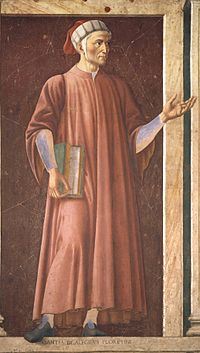
Back النهضة اللاتينية Arabic Llatí renaixentista Catalan Humanistická latina Czech Humanistisches Latein German Renesanca latino Esperanto لاتین رنسانس Persian Latin humaniste French Lingua Latina Renascentiae Latin Латынь эпохи Возрождения Russian Renesansni latinski jezik Serbo-Croatian
This article needs additional citations for verification. (May 2007) |
| Renaissance Latin | |
|---|---|
 Mural of Dante in the Uffizi Gallery, by Andrea del Castagno, c. 1450. | |
| Native to | No native speakers, used by the administrations and universities of numerous countries |
| Region | Europe |
| Era | Evolved from Medieval Latin in the 14th century; creating Neo-Latin used until present |
Indo-European
| |
Early forms | |
| Latin alphabet | |
| Official status | |
Official language in | Most Roman Catholic countries |
| Regulated by | The community of scholars at the earliest universities |
| Language codes | |
| ISO 639-3 | – |
| Glottolog | None |
Renaissance Latin is a name given to the distinctive form of Literary Latin style developed during the European Renaissance of the fourteenth to fifteenth centuries, particularly by the Renaissance humanism movement. This style of Latin is regarded as the first phase of the standardised and grammatically "Classical" Neo-Latin which continued through the 16th–19th centuries,[1][2][3] and was used as the language of choice for authors discussing subjects considered sufficiently important to merit an international (i.e., pan-European) audience.
- ^ "When we talk about "Neo-Latin", we refer to the Latin … from the time of the early Italian humanist Petrarch (1304-1374) up to the present day" Knight & Tilg 2015, p. 1
- ^ Sidwell, Keith Classical Latin-Medieval Latin-Neo Latin in Knight & Tilg 2015, pp. 13–26; others, throughout.
- ^ Butterfield 2011, p. 303
© MMXXIII Rich X Search. We shall prevail. All rights reserved. Rich X Search